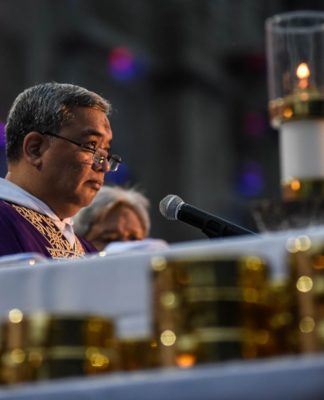THE ARCHDIOCESE of Manila has shut down the Manila Cathedral following the discovery of structural problems.
The cathedral, which is celebrating its 30th year as a basilica, was closed to the public beginning Feb. 7 and will remain shut down for a year to allow extensive repairs.
Fr. Carlos Reyes, executive secretary of Catholic Bishops’ Conference of the Philippines (CBCP)-Episcopal Commission on Interreligious Dialogue, said in an interview that the reconstruction will make the church compliant with the requirements of the 2010 edition of the National Structural Code of the Philippines.
“[One of the requirements] is to have a concrete strength of 3,500 pounds per square inch (PSI). [Some parts of] the Manila Cathedral [have] weak concrete strength of less than 600 PSI. Other parts are too strong with 5,000 PSI,” Reyes said in Filipino. “The concrete tension is also weak so we had to put steel bars around the reinforcing bars.”
The estimated cost of the repair is around P40 million to P50 million. The one-year period will include one to two months of design planning, two months of bidding for construction firms, seven months of reconstruction, and another month for other preparations, Reyes said.
Reyes gave assurances that the repair work will conserve the 1958 design of the church and adhere to the requirements of the Intramuros Administration on historical landmarks.
Major repairs include ground improvements through carbon wrapping to stabilize the foundation of the structure, steel and concrete strengthening, adjustments of the “joints,” and construction of sheer walls to protect the building from earthquakes and typhoons.
No weddings
Only weddings reserved in February and March will be accommodated, but clients were reminded of the risks concerning the church’s structural integrity. Those who chose to cancel their reservations were offered alternative churches, Reyes said.
“For weddings that will still be held inside the church, we indicated safety exits and delegated people who could help for evacuation in case of earthquakes,” Reyes said.
Parishioners may attend Masses at the San Agustin Church, the church nearest to the cathedral.
Last January, the deteriorating condition of the Manila Cathedral was reported to newly installed Manila Archbishop Luis Antonio Tagle who, along with other church officials, sought the advise of engineering consulting firm Angel Lazaro and Associates International. The firm recommended that the church be shut down for major repairs.
Reyes said the building undergoes yearly maintenance but this is the first time that it will undergo a major repair.
“We will try to fix the cracks but we will first document the structure of the church so we could preserve it,” Reyes said.
Tumultuous history
Also known as the Cathedral-Basilica of the Immaculate Conception, the Manila Cathedral serves as the country’s prime basilica and the seat of the Metropolitan Archbishop of Manila. The Archdiocese of Manila was originally part of the Diocese of Mexico. It became a separate diocese in 1571. Juan de Vivero, the chaplain on the galleon of San Geronimo, was sent by the archbishop of Mexico to establish the spiritual administration in the country, which was then newly colonized.
“Local materials, such as nipa palm and bamboo wood, were first used in the establishment of the cathedral. However, there was a time when during the procession of Saint Agustine, a candle fell causing fire in the city, destroying also the cathedral,” Reyes said.
When the Diocese of Manila became an archdiocese in the 17th century, the clergy decided to reconstruct the cathedral with stone materials. Several catastrophes came afterward, damaging and eventually destroying the church. Among these were the 1645 earthquake in Manila, the 1880 earthquake that toppled the church’s bell tower, and the bombings during the Battle of Manila in 1945.
“It was damaged or totally destroyed by earthquakes alone at least eight times, in a span of maybe 400 years. Then it was rebuilt in 1958 [under the tenure of Manila Archbishop Rufino Cardinal Santos] as what it is today,” Reyes said.


















